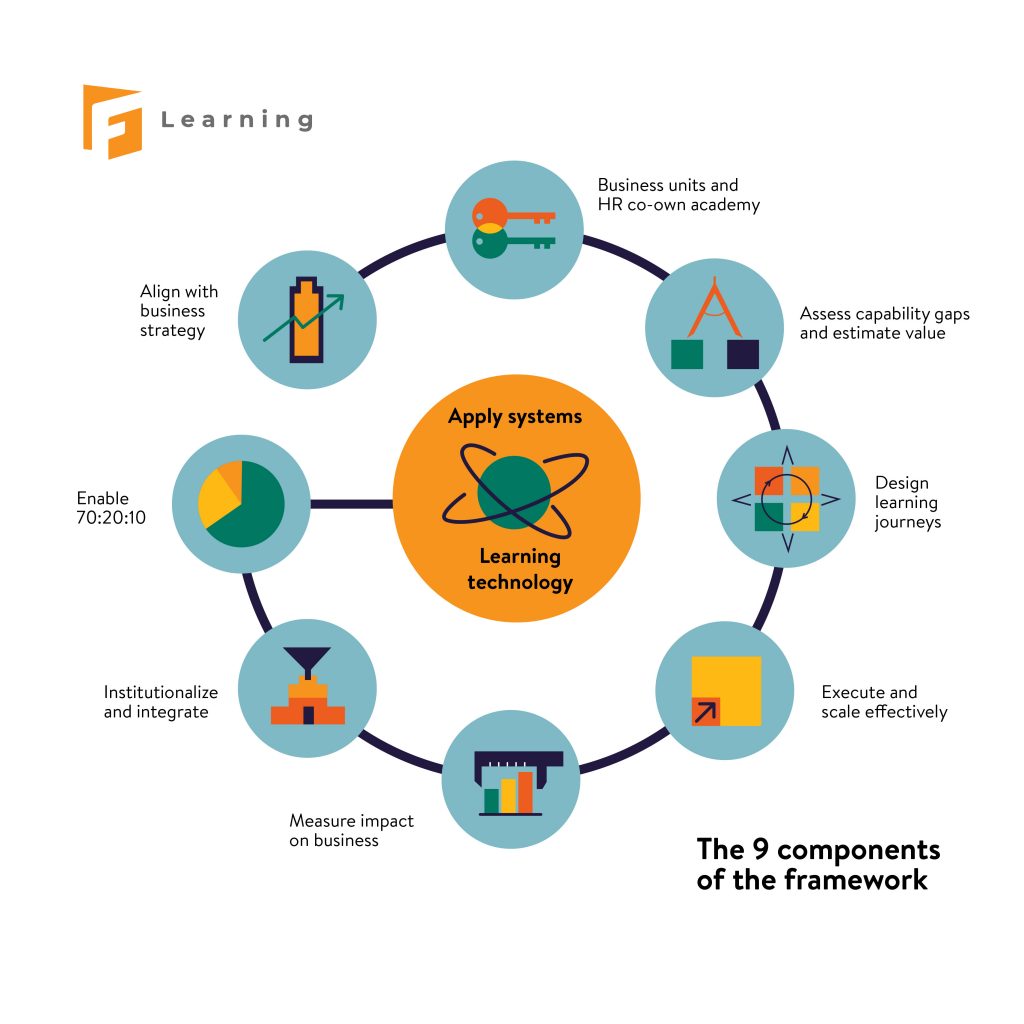In order to build an effective and efficient training program for the employees, you must first develop a better learning and development strategy that will serve as the foundation for future measurements and reflections. So, What are the most important factors to consider while developing learning and development strategies? What can we do to improve corporate learning and development? The answers to these questions can be found by reading the text. After that, you’ll be able to learn about some of the useful learning and development strategy frameworks and authentic examples. Read on!
- What is the Learning and Development Strategy?
- The Benefits of a Well-crafted L&D Strategy
- How to Create a Learning and Development Strategy: 9 Rules to Follow
- A- Alignment with business strategy (Rule 1)
- C- Co-ownership between business units and HR (Rule 2)
- A- Assessment of capability gaps (Rule 3)
- D- Design of learning journeys (Rule 4)
- E- Execution and scale-up (rule 5)
- M- Measurement (rule 6)
- I- Integration (rule 7)
- E- Enabling of the 70:20:10 learning framework (rule 8)
- S- Systems and learning technology applications (rule 9)
- 4 Learning and Development Strategy Examples
- Conclusion
What is the Learning and Development Strategy?
A learning and development strategy is a critical tool for firms to link corporate training with overall business strategies. It explains how an organization develops its workforce’s talents, skills, and competencies, which are essential to keep the business and employees on the right track while developing and accomplishing the objectives.
During the pandemic, L&D strategy may be translated into reskilling, upskilling, or skill-building overall to react to the changes quickly. Many companies have made a significant shift toward skill-building to adapt to the situation that pushes staff to adjust their work habits immediately, from office-based to remote working.
Preparation Checklist to Power your Digital Transformation
Wondering if you miss anything in your preparation to digitize your training? This is just what you need.
The Benefits of a Well-crafted L&D Strategy
To cut a long story short, the L&D strategy is built for people to manage the development of people (People here are talents, the most valuable asset of a company). A company’s learning function should play a strategic role in the following tasks.
1. Attracting talents
Attracting and retaining top talent now hinges on learning opportunities, as employees prioritize personal and professional development. The employment landscape has shifted from long-term loyalty to value-based retention, making effective learning and development strategies crucial. A lack of such programs is a common reason for employee turnover.
2. Keep employees engaged and motivated
The most effective method to keep employees engaged is to bring them opportunities to learn and acquire new skills. According to HBR, happiness is connected to lifelong learning. Highly engaged individuals are more likely to be excited by the new chances at work and content with their current company when challenged and given the ability to advance and flourish in their chosen profession.
3. Revolutionizing the company brand
Based on LinkedIn’s research on SMB Employer Brand Landscape, 72% of job seekers evaluate the employer’s brand before deciding to apply for a company. Investments in learning and development can help improve a company’s brand and reputation as an “employer of choice.” Employers must fight harder for a dwindling talent pool as substantial portions of the workforce prepare to retire. To accomplish this, they must use an employer value proposition to openly explain their brand strength.
4. Developing a knowledge-sharing system
A well-developed learning and development strategy encourages a knowledge-sharing system, helping firms to better handle their new employee onboarding, move projects across departments to team members, and overall, improve workplace openness.
5. Boosting capabilities
To maintain its worth, human capital requires constant investments in learning and development. When information gets obsolete or forgotten – which is happening more frequently these days – the value of human capital drops, and fresh learning and relevant job experiences are required to compensate. Companies that invest in the next generation of leaders receive a significant return on their investment.
6. Keeping up with changes
Firms constantly experience change management, and an L&D strategy helps organizations to establish effective and easy-to-implement reskilling programs, resulting in a flexible workplace.
How to Create a Learning and Development Strategy: 9 Rules to Follow
Rule 1: Synchronise the L&D goals and overall business strategy
Rule 2: Establish a Co-own academy between business units and HR
Rule 3: Assess capability gaps
Rule 4: Design learning journeys
Rule 5: Execute and scale
Rule 6: Measure impact
Rule 7: Institutionalize and integrate
Rule 8: Enable 70:20:10
Rule 9: Combine technology trends
What a long list of rules to remember! In short, the strategy to develop a successful; learning and development strategy, according to Mckinsey, can be condensed to a mnemonic acronym called ACADEMIES which includes 9 criteria as follows:
A- Alignment with business strategy (Rule 1)
The company’s learning strategy is to promote professional growth and create competencies across the organization on time and on budget. Furthermore, the learning method may improve business culture by encouraging employees to carry out the organization’s ideals.
The L&D department in many firms has to aid in the execution of the company plan. For example, if a digital transformation is one of the business initiatives, L&D will focus on developing the essential people competencies to make it happen.
Recommend reading:
C- Co-ownership between business units and HR (Rule 2)
There is a need to establish a co-own unit that includes the best experts from each department and the HR, which share responsibility for identifying, prioritizing, planning, and funding capability-building projects. Companies must become more agile, ready to adjust their business processes, and procedures when new tools and technology emerge. L&D operations must also be prepared to quickly implement capability-building initiatives, such as if new business demands develop unexpectedly or employees want instant training on new technologies like cloud-based collaboration tools.

A- Assessment of capability gaps (Rule 3)
Companies must ensure that their personnel can deliver on their business goals after identifying them—a job that may be more challenging than it appears. Some businesses make no attempt to analyze the staff capacities, while others do so just to a limited extent. According to L&D, HR, and senior executives, many firms are poor or indifferent at detecting capacity gaps, especially the senior or mid-level ones, who barely have time to interact with their employees.
In the post-pandemic era, the need to re-assess the workforce’s capacity is highly emergent, as the business landscape transforms from office-based to online platforms, resulting in the demand for newfound skills to support new changes. Many giant corporates have been preparing their workers to get used to “the new normal” several years ago. In order to stay competitive and close the skill gaps, employees must be assisted by leaders in developing skills that will prepare the company as a whole and its employees for the future.
Recommend reading:
D- Design of learning journeys (Rule 4)
Companies must ensure that their personnel can deliver on their business goals after identifying them – a job that may be more challenging than it appears. Some businesses make no attempt to analyze staff capacities, while others do so just to a limited extent. Many firms are poor or indifferent at detecting capacity gaps, according to conversations with L&D, HR, and senior executives, especially when it comes to senior leaders and mid-level managers.
E- Execution and scale-up (rule 5)
Traditionally, L&D training sessions included many days of classroom instruction with no follow-up sessions, despite the fact that individuals forget what they learn if it is not reinforced on a regular basis. As a result, many L&D departments are shifting away from stand-alone programs to building learning journeys, which are long-term learning experiences that incorporate on-the-job coaching, pre- and post-classroom digital learning, social learning, and short workshops or webinars. The major goals of a learning journey are to orient people in developing new abilities that facilitate learning transfer to the workplace.
Recommend reading:
M- Measurement (rule 6)
Key performance indicators should be used to assess the effectiveness and impact of a learning plan (KPIs). The first metric examines business excellence, or how well all L&D efforts and investments are connected with company goals. The second KPI examines whether learning interventions affect people’s behavior and performance. Finally, an operational-excellence KPI assesses the effectiveness of corporate academy investments and resources. Some of the key metrics to evaluate the training programs include:
- Strategic alignment: assuring the learning strategy gives base support to the organization’s priorities.
- Capability enhancement: helping colleagues build the mindsets, skills, and expertise they need most. People’s competence deficiencies can be assessed against a complete competency framework to determine the impact.
- Organizational health: producing the learning strategy that strengthens the overall health and DNA of the organization. Relevant dimensions of the McKinsey Organizational Health Index can provide a baseline.
- Individual peak performance: help colleagues achieve maximum impact or the specialist level in their role while maintaining a healthy work-life balance.
Recommend reading:
I- Integration (rule 7)
L&D corporate-learning efforts should be connected with the business, and they should be a part of the HR agenda as well. Recruitment, onboarding, performance management, promotion, workforce, and succession planning are all areas where L&D may help. According to our findings, many L&D functions have only shaky ties to yearly performance assessments and lack a defined strategy and follow-up to performance management techniques.
L&D executives must be familiar with important HR management techniques and procedures and work closely with HR executives. For their capability-building agenda, the finest L&D departments employ aggregated development feedback from performance assessments as input.
E- Enabling of the 70:20:10 learning framework (rule 8)
Many L&D departments use the “70:20:10” concept, in which 70% of learning occurs on the job, 20% via contact and cooperation, and 10% through formal learning interventions including classroom training and digital courses. These percentages are only suggestions, and they will differ depending on the industry and organization. Traditionally, L&D responsibilities have concentrated on the formal learning component.
To successfully apply the framework to practical training, leaders in learning and development must now create and execute interventions that enhance informal learning. On that note, in terms of connecting specialists and developing and sharing information, social technologies are becoming increasingly important.
Recommend reading:
S- Systems and learning technology applications (rule 9)
Coming after the digital transformation during and after the crisis, technology platforms and apps are the most important enablers for just-in-time learning. Learning and development leaders must ensure that learning technologies are integrated into a larger system architecture that supports the entire talent cycle, including recruiting, onboarding, performance management, L&D, real-time feedback tools, career management, succession planning, and rewards and recognition.
Recommend reading:
4 Learning and Development Strategy Examples
1. IBM’s Basic Blue
IBM’s Basic Blue program is a foundational training initiative designed to integrate new hires into the company’s culture and operations. The program offers a blend of classroom and online training, focusing on IBM’s history, values, business practices, and client-facing skills. It also emphasizes leadership development, encouraging employees to take ownership of their career growth.
2. Google’s 20% Time
Google’s 20% Time policy allows employees to dedicate 20% of their workweek to pursue personal projects or ideas outside of their assigned duties. This strategy fosters innovation and creativity, encouraging employees to explore interests that could benefit the company. Many of Google’s most successful products, including Gmail and Google News, originated from 20% Time projects.
3. McDonald’s Hamburger University
McDonald’s Hamburger University is a global training center that equips employees with the skills needed to run a successful McDonald’s franchise. Founded in 1961, the university offers courses on leadership, operations, and business management. With campuses around the world, it trains thousands of employees annually, ensuring consistent quality and service standards across its restaurants. The program emphasizes practical skills and corporate culture, preparing managers to maintain McDonald’s high standards.
4. Adobe’s Leadership Circles Program
Adobe’s Leadership Circles program is designed to nurture and develop future leaders within the company. The program involves a series of peer-led group discussions, where employees from different departments share experiences, insights, and challenges. These circles focus on building leadership competencies, emotional intelligence, and cross-functional collaboration. Participants are encouraged to reflect on their personal leadership styles and develop strategies for effective team management.
Conclusion
There are recipes for different dishes, and so is for L&D strategy. Leaders of L&D functions must reinvent their own approach by developing a learning and development strategy that is aligned with business goals to identify and facilitate the skills required for success. The most successful businesses will invest in cutting-edge learning and development programs, maintain flexibility and agility, and develop the human capital required to succeed in the digital era. These improvements come with some risk and maybe some trial and error, but the payoff is worth the effort.
If you have any concerns or want to upgrade your corporate training with tailored visual solutions, F. Learning can give you a hand. From interactive design to animated videos, we have something to help you increase learners’ attention and boost knowledge retention. Contact us now for a FREE consultation:
- WhatsApp: (+84) 378 713 132
- Email: [email protected]
- Fanpage: https://www.facebook.com/f.learningstudio
- LinkedIn: https://www.linkedin.com/company/f-learning-studio/
Read more:











